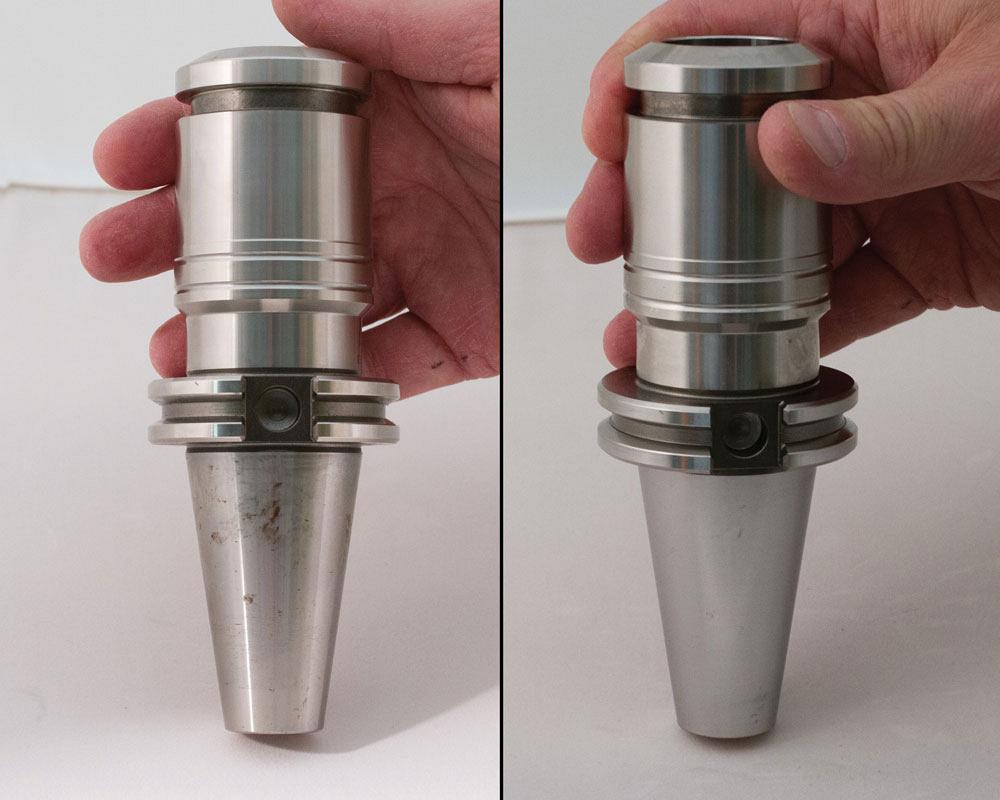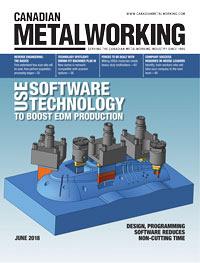- FMA
- The Fabricator
- FABTECH
- Canadian Metalworking
Forces to be dealt with
Milling HRSA materials needs heavy-duty toolholders
- By Sue Roberts
- June 14, 2018
- Article
- Cutting Tools
The metallurgical makeup of heat-resistant super alloys (HRSA) makes them tough. These nickel-, iron-, and cobalt-based superalloys and titanium alloys maintain their strength at high temperatures, which makes them a particularly good fit for components used in the aerospace, energy, and medical industries. It also makes them a machining challenge that begins at the edge of the cutting tool and moves all the way through the machine tool itself. That includes added stress on the toolholder.
More power and cutting force, almost twice as much as needed for low-alloy steel, typically are required to machine these high-tensile-strength, pricey materials. “The increased force and power needed with cutting HRSA flow through the assembly into the toolholders and shorten their life expectancies,” said Brian MacNeil, milling products and application specialist for Sandvik Coromant. “Heavier, specially designed toolholders need to be used to stand up to these forces and provide a stable cutting process for good-quality parts.”
Tool pullout that could cause enough damage to send a high-value part to the scrap bin can become more of an issue when milling HRSA materials. Toolholder gripping strength needs to be powerful.
David McHenry, engineering and technical manager for Rego-Fix Tool Corp., said, “Cutting tools need to be positively locked into the toolholder so you can get higher torque out of the cutting tool and be sure the tool isn’t going to move during the cutting process. The grip has to be strong enough to maintain the lock on the tool, but there needs to be a way to avoid component damage if a problem should develop during the process.
Toolholder manufacturers have developed ways to ensure that the only failure mode is to have the tool snap off at the end mill. The tool can be replaced, not the entire part.”
HRSA Toolholder Features
Forces generated when cutting HRSA materials can be extreme enough to deflect or bend standard toolholders. When that happens, the cut will no longer be true or accurate. Bent toolholders will cause vibrations that mar the surface finish. Toolholders designed to work with the challenging materials can be heavier and/or constructed from hardened materials to increase rigidity and may include special features to assist the process.
MacNeil said, “Toolholders produced from quality materials and machined in a hardened state offer better resistance to deformation and have better runout qualities. They will also include adjustable coolant nozzles at every insert to maximize cooling in the cutting zone and keep the heat away from the inserts and cutter body.”
McHenry said, “More material in the side wall of our heavy-duty toolholders gives them almost twice the rigidity of the standard holders. And they have vibration-dampening features that help preserve cutting tools. The chip edge still wears, but it survives so that it can be resharpened.”
Heavy-duty toolholders are also getting shorter to help maintain rigidity. As a toolholder gets closer to the spindle nose, it tends to experience less vibration along with the higher rigidity.
Heavy-duty TLC
The connection that runs all the way through the tooling assembly needs to be constantly monitored and maintained to keep making successful cuts.Cleanliness, as in any chip environment, is critical. “Chips, or even dust, that get into the spindle pocket between the spindle and the toolholder can cause the toolholder taper to prematurely wear and negatively affect the connection. Maintaining that solid connection is important to reduce vibration and maintain accuracies. The more metal-to-metal contact, the better,” said McHenry.

Chips or any type of dirt on a spindle interfere with the toolholder connection and cutting accuracies. Photos show a spindle before and after being cleaned. Photos courtesy of Rego-Fix Tool Corp.
“The other maintenance procedure goes back to simple assembly operations. If you use a steep-taper holder, be sure to have the correct pull stud torque and check that the drawback mechanism pulls back the way it should. If any one of the tool assembly components is assembled wrong or is failing it will affect how accurate you cut, how fast you cut, and how long you can cut,” McHenry continued.
Check the pull stud torque every time you assemble a new toolholder, McHenry added, and put a check of the draw bar force on a regular maintenance schedule to be sure retention force hasn’t been lost.MacNeil said, “An increased frequency of inspecting insert seats or contact points on the toolholder body for damage is critical. Inserts that are not properly supported can begin to move or rotate under load and cause failures.
“Insert screws can also become a weak link in the security of the process. They should be replaced more frequently when milling HRSA. Always use an anti-seize lubricant on your screw threads.”
Multitasking Considerations
Rigidity, both axially and radially, is needed to get good results from a multitasking operation. Contact between the tapers and the flanges needs to be vibration-free and secure to produce quality surfaces and dimensional accuracies. Opinions on what type of toolholder will perform best vary, but experts agree that milling HRSA materials requires special considerations.
“Toolholding needs vary so much depending on the component, tool, and workspace available, but the best toolholding strategy comes from having quality holders that offer minimal runout and the shortest possible gauge length,” said MacNeil. “The capacity for these materials to pull a tool out of a weak toolholder is very high. Choose hydraulic chucks, a heat-shrink system, mechanical milling chuck, or precision Weldon holder to prevent this type of problem.”
McHenry said, “Depending on tool size, a good ER system can have more gripping strength than a hydraulic or even a shrink holder, but I would rule them out because of rigidity problems. The same goes for a hydraulic chuck, there is potential for the chamber to flex allowing the tool to move. Typically we see shrink-fit, powRgrip, and milling chucks used on these materials.
Associate Editor Sue Roberts can be reached at sroberts@canadianmetalworking.com
Rego-Fix Tool Corp., https://us.rego-fix.com/en
Sandvik Coromant, www.sandvik.coromant.com
About the Author

Sue Roberts
2135 Point Blvd
Elgin, IL 60123
815-227-8241
Sue Roberts, associate editor, contributes to both Canadian Metalworking and Canadian Fabricating & Welding. A metalworking industry veteran, she has contributed to marketing communications efforts and written B2B articles for the metal forming and fabricating, agriculture, food, financial, and regional tourism industries.
Roberts is a Northern Illinois University journalism graduate.
subscribe now


Keep up to date with the latest news, events, and technology for all things metal from our pair of monthly magazines written specifically for Canadian manufacturers!
Start Your Free Subscription- Trending Articles
Automating additive manufacturing

Sustainability Analyzer Tool helps users measure and reduce carbon footprint

CTMA launches another round of Career-Ready program

Sandvik Coromant hosts workforce development event empowering young women in manufacturing

GF Machining Solutions names managing director and head of market region North and Central Americas

- Industry Events
MME Winnipeg
- April 30, 2024
- Winnipeg, ON Canada
CTMA Economic Uncertainty: Helping You Navigate Windsor Seminar
- April 30, 2024
- Windsor, ON Canada
CTMA Economic Uncertainty: Helping You Navigate Kitchener Seminar
- May 2, 2024
- Kitchener, ON Canada
Automate 2024
- May 6 - 9, 2024
- Chicago, IL
ANCA Open House
- May 7 - 8, 2024
- Wixom, MI

















